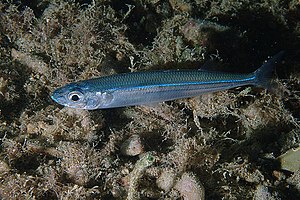Earfish relatives
| Earfish relatives | ||||||||||||
|---|---|---|---|---|---|---|---|---|---|---|---|---|

Atherina Hepsetus from the order Atheriniformes |
||||||||||||
| Systematics | ||||||||||||
|
||||||||||||
| Scientific name | ||||||||||||
| Atherinomorphae | ||||||||||||
| Greenwood , Rosen , Weitzman & Myers , 1966 |
The earfish relatives ( Atherinomorphae) are a group of bony fish from the group of perch relatives (Percomorphaceae). It is mainly small to medium-sized fish that often live near the surface of the water. 75% of the species occur in freshwater and brackish water , the rest near the coast in the sea.
features
The earfish relatives have a protruding (protractile) upper jaw, which, unlike other barbed fish, does not have a ball joint between the palatine bone and the maxillary . They also lack the crossed ligaments between the two bones. The edges of the gill cover and veal cover are unsawed and have no spines. Comb flakes are rare. The number of Branchiostegal rays is 4 to 15.
Reproduction
Originally they were soil spawners. Their eggs have characteristic threads for anchoring. Several groups have independently developed viviparia . The spermatogenesis takes place of the tubule / Lomulus (a portion of the testes) only in the distal (from the middle of the body directed away) portion. All sperm do not have an acrosome (head cap of the sperm), but otherwise differ greatly. The atherinomorphae are also the only species of bony fish that consist exclusively of females. There are the Old World silverside Menidia clarkhubbsi and some Livebearers from the genera Poecilia and Poeciliopsis .
Systematics
External system

The earfish relatives are classified in the barnfish (Acanthopterygii) and there traditionally contrasted with the perch relatives. Phylogenetically , however, they are part of the perch relatives. There they belong to the monophyletic ovalentaria , which also include the mullet-like (Mugiliformes) and some other groups that also lay demersal (sinking to the ground) eggs provided with adhesive filaments.
Internal system
According to Nelson, 1,552 recent species, 193 genera, 21 families in the following three orders belong to the earfish relatives.
-
Earfish relatives (Atherinomorpha)
- Atherinea
- Order earfish (Atheriniformes)
- Cyprinodontea
- Order garfish (Beloniformes)
- Order Zahnärpflinge (Cyprinodontiformes)
- Atherinea
swell
literature
- Britz, Ralf (2004): Teleostei, beinfische ieS p. 275 in Westheide, W. & Rieger, R .: Special Zoology Part 2: Vertebrae and Skull Animals , 1st edition, Spectrum Academic Publishing House Heidelberg • Berlin, ISBN 3-8274- 0307-3
- Dyer, BS and B. Chernoff (1996): Phylogenetic relationships among atheriniform fishes (Teleostei: Atherinomorpha) . Zool. Journ. Linn. 117: 1-69.
- Hertwig, ST (2008): Phylogeny of the Cyprinodontiformes (Teleostei, Atherinomorpha): the contribution of cranial soft tissue characters . Zool. Scripta, 37 (2): 141-174.
- Nelson, JS (2006): Fishes of the World . John Wiley & Sons, ISBN 0-471-25031-7 .
Individual evidence
- ↑ Nelson (2006)
